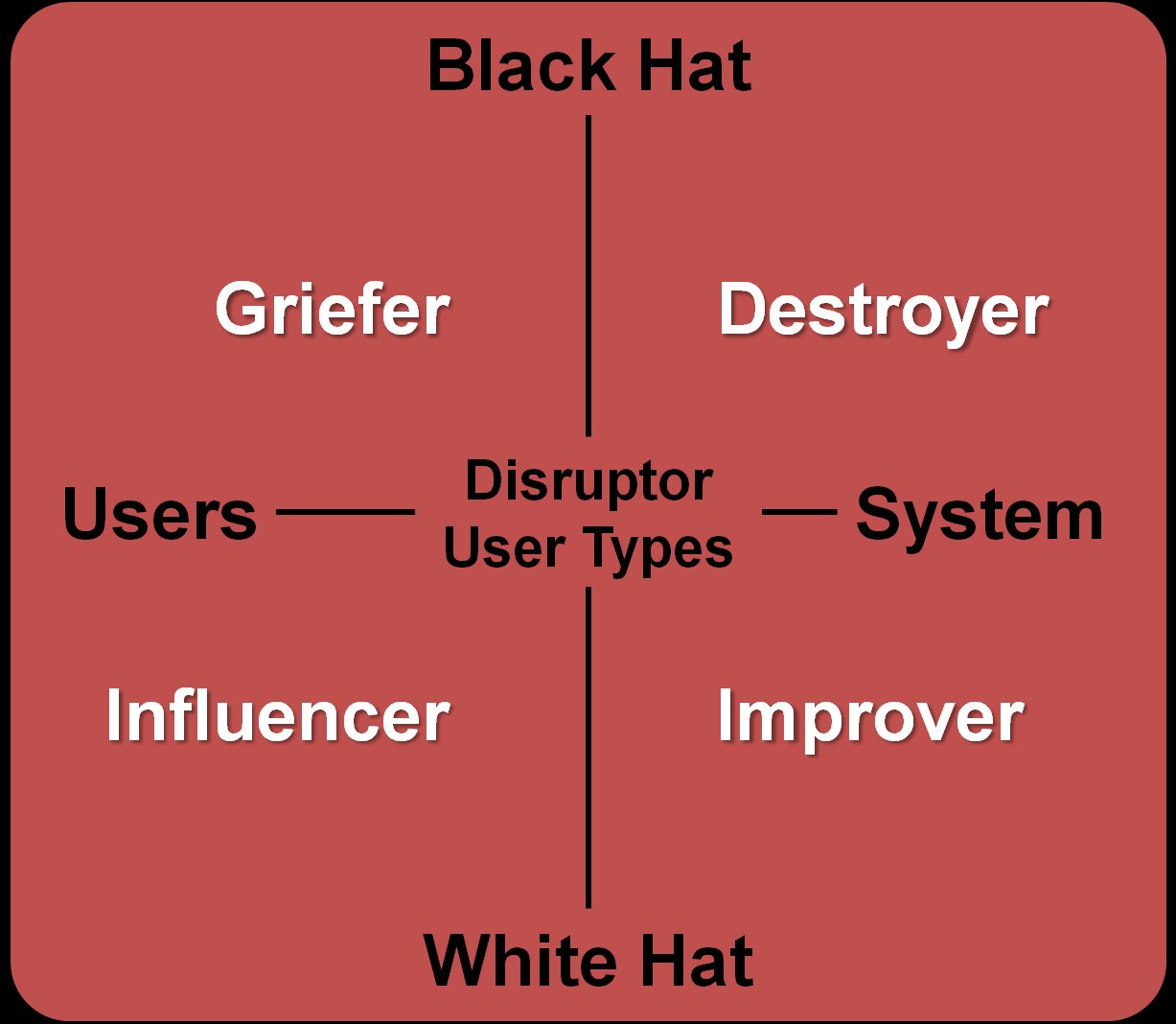If you have looked at my User Types HEXAD or read any of my work (hey, Even Ninja Monkeys Like to Play is a great Christmas present to yourself or anyone you love….), you will have noticed that Disruptors are often portrayed as the bad guys of the group. Now, this is for good reason in some respects, I added them due to some observed bad behaviors in systems I had been involved with. Turns out gamified systems are not eutopian worlds of love, points and badges… Some people just enjoy being a pain in the butt!
hexad
Amazing Interactive Mind Map For The User Type Hexad
This is really cool. I didn’t make it either, Sinan Sensivas did.
It is an interactive mind map of my Hexad and game mechanics. It’s really fun and an interesting way to learn it all.
Take a look and say hi to Sinan on Twitter
The Mindmap!
Introduction to Gamification Part 8: User Types
There are many views on user profiling and many ways to do it. Some people love it, some hate it. I am in the middle. It is a very useful tool, but it is not the only thing you should rely on. For me, they can be a useful way to understand or at least considers the motivation so those who will be using your system.
Bartle’s Player Types
In the games world there are a few famous player type models, Bartle’s Player Types being the most well known [1]. In these he breaks down players of his famous Multi-User Dungeon (MUD) game into 4 key types. Killer, Achiever, Socliasler and Explorer. Each type of player had a different motivation to play the game.
Very simply put, Killers are there to impose their will on other players, Achievers want to be the best at everything, Socialsiers want to meet people and Explorers want to explore the boundaries of the game.
He later created an expansion on the 4 types, by splitting them into 8 based on their behaviour being implicit or explicit. For example, if a killer was just plain out to hurt people, their killer behaviour could be considered implicit (they don’t realise they are doing it) and they are a Griefer. If they were more of a mother hen style character, who felt that imposing their will on others was actually for their benefit, the behaviour was explicit and they are a Politician!
Now, I could go further, but this is meant to all be about introductions. Suffice to say, Bartles Player Types are an amazing tool to help you design multi-player role-play games – that is what they were designed for. By his own admission, they are not well suited to other applications – even though they can be seen used in everything from gamification to marketing and sales!
Marczewski’s User Types
That brings us to my User Types or the HEXAD[2]. Again, as this is an introduction, long story short – I created these over the course of a couple of years to offer an alternative to Bartle’s types that was more applicable to gamification design. In fact, Bartle helped me build them. There has been a lot on this site about them, but a good place to start is on the User Types page . There has also been a fair amount of academic research done around them and a survey I created to help tell you what your User Type is [3][4].
In my model, I propose six types of users (at a basic level); four intrinsically motivated types and two others.
Achiever, Socialiser, Philanthropist and Free Spirit. They are motivated by Relatedness, Autonomy, Mastery and Purpose (RAMP: which you will remember from Part 4 of this series) [5].
The other two types, whose motivations are a little less black and white are Disruptor and Player.
The Types
User Types HEXAD: What Links Philanthropists to Socialisers
One of the findings is something that has been noted before and is not a surprise to me, but something I realise I have never explained. The finding is that the Philanthropist and Socialiser types are very closely linked when you look into them.
Furthermore, the evidence suggests there is a stronger correlation between the Philanthropist and Socialiser types than the theory anticipated, suggesting the possibility of an improvement to the theory itself, i.e., it should acknowledge that a person who is highly motivated by philanthropism will probably also be motivated by socialization in some degree, and vice versa. [1]
Considering Age and other factors in Gamification
What is very nice these days, is how easy it is to dispell these myths with statistics (yeah I know, Lies, Damned Lies and Statistics).
Roughly (I say this as this is coming from multiple sources and 2017 quarters), in the UK, 43% of people aged 6-64 say that they play video games in some form. Of that group, 57% are male, 43% female. If we consider that working age is around 18 to 60 (ish), you are looking at about 78% of the total gaming group are potentially playing games., peaking around the 25 to 44 age group, but still significant in the 44 to 64 age group.
That means that if 43% of the population is playing games, and 78% of that is in the workforce that shows that at least 30% of your workforce are officially gamers – across all age groups. That may not seem a huge number but think of that as 30% who are easy to engage with good gamification.
There is still 70% left. Now, if you read my blog the other day about the 70/30 rule, you will know that we can assume that around 30% of people will find a reason not to engage, no matter what you do! So actually that leaves us with 40% left to engage in some way.
That is where understanding the population of your employees and their motivations is so important. User Types can help a little here, but not in the way I normally speak about them.
Age Does Make A Difference
Sure, knowing the general motivation of your users is great, but actually, there is something else we can learn from the user types. How age affects your motivations. The most recent analysis of my survey shows some very obvious differences around age groups (remember that age is not as big a determining factor on who plays games as you may think).
Whilst Relatedness, Disruption, Mastery (mostly) and Autonomy stay stable across age groups, Altruism (Purpose) and the desire for Rewards seem to change dramatically!
There are probably many factors that affect this, but it is safe to say that when designing systems, you need to consider that the older users will be far less interested in the shiny things over time, and much more interested in ways to give back to the system.
How do you do that?
Well, one of the things I find my self doing more and more is wanting to teach others, to share my knowledge in some way. That may be simple in a learning platform, by giving people mentor roles, but in something like an onboarding platform – where everyone ins new – that may seem much harder!
However, you can learn by teaching. I have started to teach guitar recently, but I am not the most knowledgeable on the theory side. So, I am onboarding myself into the theory by learning it in a way that allows me to effectively teach it to others. It is very focusing to know that you need to understand something well enough to be able to explain it to others in a way they can understand – and that is actually correct! It is like learning by doing on steroids!
No Excuses
By creating gamified systems that are non-patronising, don’t rely entirely on being gamey and gimmicky and by understanding the differences between people, their interests, motivations, ages, genders etc, you can cover that 40% that are “tougher” to engage with game-based solutions. But what you can’t do is say that “XXX don’t play games”, because it is a fairly high probability that they do. Just ask my 79 year old Dad when he is playing his nightly game of Call of Duty!!





